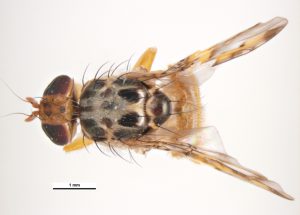The Mediterranean Fruit Fly is commonly referred to as the “Medfly.” It is one of the most serious fruit fly pests in the world, due to its ability to colonize a wide variety of fruit crops. This pest as been detected in Florida, but eradication efforts have prevented it from establishing permanently. Females deposit their eggs under the skin of the fruit, often in wounds that were already present. They may lay up to 75 eggs in one spot, and 300-800 within their lifetime. Females will live 2-3 months depending on the host plant and environmental conditions. In favorable environments like Florida, populations can explode within a few months.

Adult medflies are yellow-white in color with black blotches on the thorax. There are small white bristles on the lighter areas in between the black spots.

For more information on the Mediterranean fruit fly, check out this Featured Creatures article by Thomas et al. (2001).
 0
0
